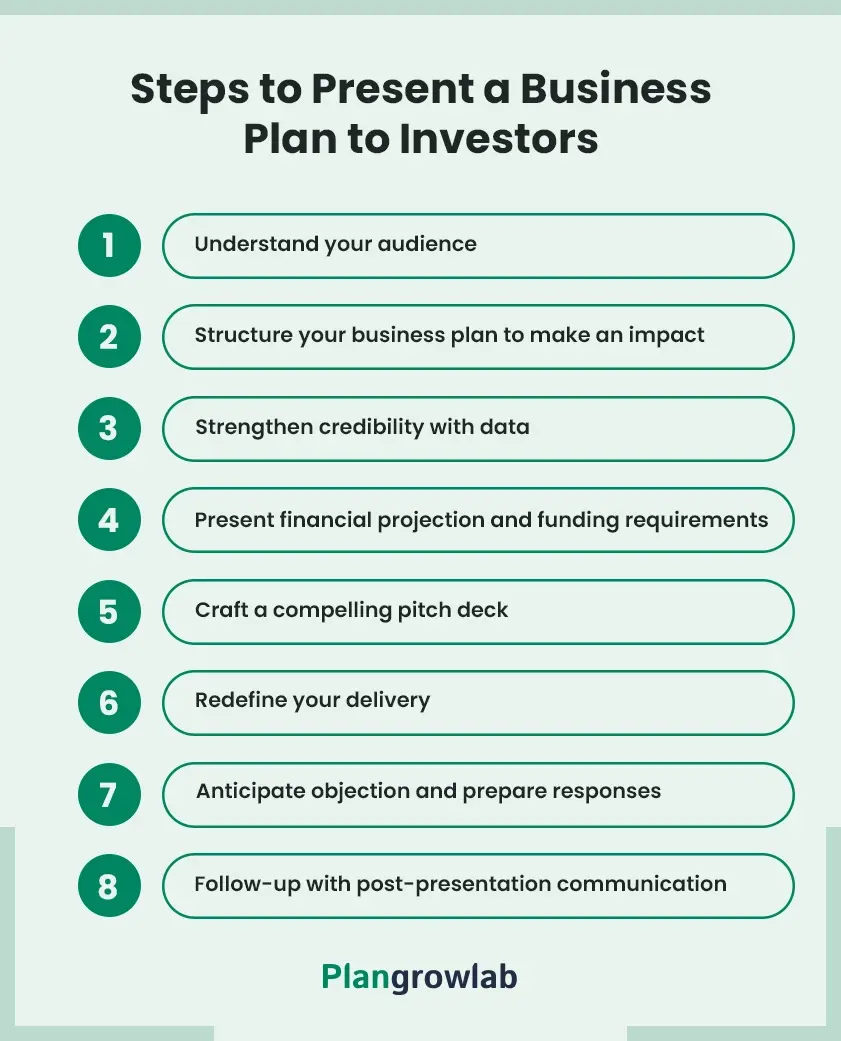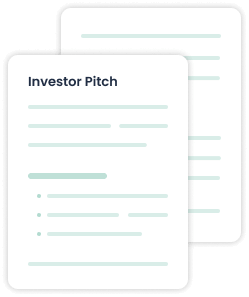“The most important single ingredient in the formula of success is knowing how to get along with other people.”
Theodore Roosevelt, the US 26th President, wasn’t talking about investors, but he might as well have been.
In our consulting work, we’ve seen great business plans fall flat because the founder couldn’t build trust in the room.
That’s the part no one prepares you for: You’re not just sending a plan; you’re selling your vision to people who need to believe in you. And that changes how you write, structure, and present your plan.
In investor meetings, how you communicate the plan is just as important as what’s in it. Clarity, structure, tone, and delivery all matter. Because at the end of the day, you’re asking someone to trust you with their money.
If you’re wondering how to present a business plan to investors, we’ll show you what that looks like in practice, from messaging to delivery.
Why is presenting your business plan effectively to investors crucial?
Investors look at your business plan as the only tool to gauge your business potential and capabilities. Hence, presenting it effectively will only increase their confidence and willingness to invest.
Here are five core reasons highlighting why an effective business plan is crucial for gaining investor confidence:
The first impression matters
A well-structured presentation creates a positive first impression. Investors often make quick judgments based on initial interactions, so a clear and professional presentation can set the tone for further discussions.
Builds trust and credibility
Effective communication demonstrates your knowledge and confidence in your business. Articulating your vision and strategy instills trust in investors, showing them you’re serious and prepared.
Engages and captivates the audience
An engaging presentation keeps investors interested and focused. By telling a compelling story about your business, you can create emotional connections that make investors more likely to support your vision.
Clarifies your value proposition
A strong presentation allows you to convey what sets your business apart from competitors concisely. Clearly defining your unique selling points helps investors understand the potential for success and return on investment.
Facilitates questions and feedback
A well-prepared presentation opens the door for constructive dialogue. By inviting questions and being open to feedback, you show that you value investors’ insights, which can strengthen relationships and improve your business strategy.
8 Steps to present a business plan to investors
Over the years, we’ve worked with dozens of founders to prepare for investor meetings, and we’ve seen what works (and what misses). Here are the 8 practical steps we recommend if you want to present your business plan in a way that builds confidence and gets buy-in.

1) Understand your audience
To make your business plan effective for your investors, start by researching your investors beforehand.
Find out what industries they prefer, what types of companies they typically fund, and what their main concerns are.
Use this insight to tailor your presentation by highlighting aspects of your business plan that align with their interests.
Understanding your audience will help you craft a business plan that speaks directly to their goals and priorities. Because every investor has different priorities and risk appetites.
Venture capitalists, angel investors, and institutional investors, for instance, all have unique expectations and criteria when assessing business plans. Crafting a business plan with a tailored approach makes your presentation relevant and demonstrates your commitment.
We see founders lose investor interest by giving everyone the same generic pitch. That’s why we always ask: “Who’s in the room, and what are they really looking for?” Once we know that, we shape the plan’s messaging to match what the investor cares about most, whether it’s recurring revenue, defensibility, or early traction.
You can do the same. Start with their lens, not yours. The right framing changes everything.
2) Structure your business plan to make an impact
A clear and logical structure helps investors quickly understand your business and its potential, creating a lasting impression.
When a plan is well-organized, it allows investors to absorb the information more efficiently and keeps their attention.
You can start structuring your business plan in the following sequence:
- Executive summary
- Pain points of customers
- Solution your business offers to pain points
- Target market and market analysis
- Business model (Describe how your business makes money)
- Competitive analysis
- Marketing strategy
- Product/service offerings (Unique features and benefits)
- Financial projections
- Funding requirements
- Management team
- Exit strategy
A common problem we see great ideas being buried in bloated, hard-to-skim drafts. The goal is to say the right things in the right order. That’s baked into how we build and revise plans: Cut the clutter, surface the opportunity, and guide the reader straight to important parts.
For guidance on the ideal length, check out our blog on the right length of a business plan.
3) Strengthen credibility with data
Investors are more likely to trust a plan backed by solid data. Data with good numbers seek investors' attention and reinforce your business model's viability.
As consultants, we’ve sat through enough investor calls to know what breaks a founder’s pitch. Some of them include vague market claims, inflated revenue charts, or metrics pulled from outdated sources. Investors pick up on that fast.
That’s why we insist on rooting everything in research. Our team diligently reviews industry benchmarks, validates assumptions, and ensures key data points are investor-proof. Sometimes that means pushing back on unrealistic figures, or helping clients sharpen a good insight into a great stat.
Always back your claims:
- Instead of “growing market,” cite projected CAGR from a trusted report
- Instead of “strong early traction,” show CAC vs LTV with source notes
- Use charts, graphs, segment breakdown so investors absorb the numbers without getting lost in a spreadsheet
Good data doesn’t just support your story, it becomes part of it. And in high-stakes meetings, that’s what sets serious founders apart.
4) Present financial projection and funding requirements
This is one of the most critical steps in presenting a business plan to investors, as they will certainly want to grasp the financial potential of your business.
It’s not enough to say you expect growth or need funding. Investors want specifics: Realistic revenue, cost, and profit forecasts for the next 3-5 years, as well as a clear breakdown of how much funding you need and how it will be allocated (e.g., operations, marketing, R&D).
In our consulting work, we’ve seen founders struggle here because they try to oversimplify the numbers or, worse, inflate them. What works better is a grounded, transparent projection even if the numbers are modest.
If you're not sure how to structure this part, use a table like the one below. It breaks down the funding ask into specific, justifiable categories.
| Funding Requirement | Amount Requested | Purpose | Justification |
|---|---|---|---|
|
Operational Expenses
|
$50,000 | Salaries, rent, utilities | To cover the first six months of operations |
|
Marketing and Advertising
|
$30,000 | Digital marketing, PR campaigns | To increase brand awareness and customer acquisition |
|
Product Development
|
$40,000 | Research, design, prototyping | To finalize product development and testing |
|
Inventory
|
$20,000 | Initial stock for launch | To ensure adequate supply for the first quarter |
|
Technology and Equipment
|
$15,000 | Software, hardware, and tools | To enhance operational efficiency |
|
Legal and Professional Fees
|
$10,000 | Incorporation, patents, and contracts | To ensure compliance and protection of intellectual property |
|
Miscellaneous
|
$5,000 | Contingency fund | To cover unexpected expenses |
|
Total Funding Required
|
$210,000 |
5) Create a compelling pitch deck
A strong business plan is essential, but when you're in the room with investors, it’s your pitch deck that does the talking. And it has to do it fast.
From what we have seen, the best pitch decks are structured tools that make it easier for investors to understand your business in minutes rather than pages. You don’t have to show everything; just show the right things clearly.
Use 10–12 well-designed slides to walk through:
- Product name and tagline
- The problem your audience faces
- Your solution and why it works
- Target market and opportunity
- Revenue model
- Competitive landscape
- Go-to-market strategy
- Financial projections
- Funding ask and use of funds
- Team
- Timeline or traction (if available)
We help our clients strip out clutter from their decks, replace dense bullet points with sharp visuals, and bring consistency to the story. That polish goes a long way. Especially when you’re one of ten founders they’re meeting that day.
If you need a clean, investor-ready deck that aligns with your plan, it’s something we help with regularly.
6) Redefine your delivery
Your delivery can significantly impact how your pitch is received. A confident and engaging presentation captures attention and instills trust as well as credibility in your business.
We’ve sat in over 100 mock investor sessions with clients and one pattern always stands out. It’s not always the sharpest financials or the sleekest deck that wins the room. It’s the way the founder delivers it.
You don’t need to sound like a TED speaker. But you do need to sound like someone investors can trust with their money.
Here are a few tips that you can use to nail your presentation:
- Rehearse your pitch multiple times to build confidence and familiarity with the content.
- Anticipate questions and be prepared to provide detailed answers.
- Make eye contact, use body language, and interact with your audience.
- Start with a compelling hook to grab attention and finish with a powerful closing statement.
- Show enthusiasm and belief in your business.
- Speak clearly and at a measured pace.
- Refer to your pitch deck as a guide rather than reading from it.
How you deliver bridges your business plan and the funding you're asking for.
7) Anticipate objections and prepare responses
A strong follow-up shows investors that you’re proactive and committed. It keeps your business top-of-mind, providing further information if needed and helping to build relationships.
Hence, make a list of possible investor questions or concerns, such as market competition, scalability, or revenue models. Prepare responses that are clear, concise, and backed by data.
Practicing these responses with someone else can help you stay calm and confident at the moment.
8) Follow-up with post-presentation communication
A strong follow-up shows investors that you are proactive and committed. It keeps your business top-of-mind, providing further information if needed and helping to build relationships.
Send a concise, polite follow-up email thanking them for their time and offering to answer any additional questions.
Include any documents, data, or further information they requested during the presentation. Keep the conversation open but don’t overwhelm them with too much information.
Mistakes to avoid while writing a business plan to present investors
To make a strong impression on your investor, be sure to sidestep these common mistakes:
Don’t overload information
Avoid including excessive details that can overwhelm investors. Stick to high-impact, relevant points that demonstrate your business's value.
Don’t lack with objectives
Failing to clearly define goals or milestones can make your business seem directionless. Investors want to see a roadmap with specific, measurable objectives. If you're unsure how to frame those goals clearly, that's something we often help founders refine.
Don’t forget to analyze the market in-depth
Insufficient research on your target market or competition can make your plan seem unconvincing. Include data-backed insights that show you've thoroughly analyzed the market landscape.
Many of our clients come in with assumptions so we pressure test those with data and help turn them into investor-ready insights.
Avoid over-optimizing your financial projection
Unrealistic revenue and profit forecasts are a red flag for investors. Ensure your projections are grounded in realistic assumptions and supported by market data.
Don’t ignore risks and challenges
Presenting your business as foolproof can appear naive. Be honest about potential risks and how you plan to mitigate them; this demonstrates maturity and preparedness.
Don’t neglect the competitors
Overlooking or dismissing competitors can make investors skeptical. Show you understand your competitive landscape and have a clear strategy for differentiation.
Avoid poor writing and presentation
A cluttered or unprofessional design and writing can detract from your message. Use a clean, visually engaging format that aligns with your brand and enhances readability.
Don’t neglect legal requirements
Overlooking necessary legal or regulatory considerations can lead to significant issues later on. Ensure compliance with all relevant laws and include this information in your plan.
Conclusion
Capturing investor attention in your business plan requires a compelling spark that aligns your vision with their interests and goals. You can ignite that spark by following the steps outlined in this blog.
But be mindful of the common mistakes highlighted here to strengthen your pitch and maximize your chances of winning investor support.
Remember, creating a professional and effective business plan takes skill and experience. If you’d like guidance, a business plan constant can be invaluable to help refine your message and present your business with confidence.
You may contact Plangrowlab to hire a team of skilled business plan consultants where we deliver results by helping businesses create comprehensive plans that impress stakeholders and investors alike.
Our experts will not only guide you in writing a business plan but also provide you with valuable insight to help you navigate complex business landscapes.
Get in touch now!
Frequently Asked Questions
How long should the business presentation be?
Aim for a 15-20 minute business presentation. Keep it concise but engaging, leaving room for a Q&A session.
What should I do if an investor asks a question I don’t know the answer to?
Be honest if you don’t know the answer, and offer to follow up with the information after the meeting. This approach shows integrity and a commitment to thoroughness.
Is it okay to send my business plan before the pitch meeting?
Yes, sharing a brief overview or executive summary in advance can help investors prepare and identify areas they’d like to discuss further during your presentation.
How detailed should the financial projections be?
Provide a high-level view with realistic projections for 3-5 years, including major assumptions. Investors should see clear revenue growth, cost forecasts, and profit margins.
What mistakes should I avoid during my pitch?
Avoid overloading with details, being overly optimistic, dismissing competitors, and neglecting to address risks. Aim for clarity, honesty, and strategic focus.
How much financial detail should I include in my presentation?
Cover key financial metrics, including revenue, expenses, profit margins, and funding requirements. Detailed financials can be included in a handout or appendix if investors request more specifics.


